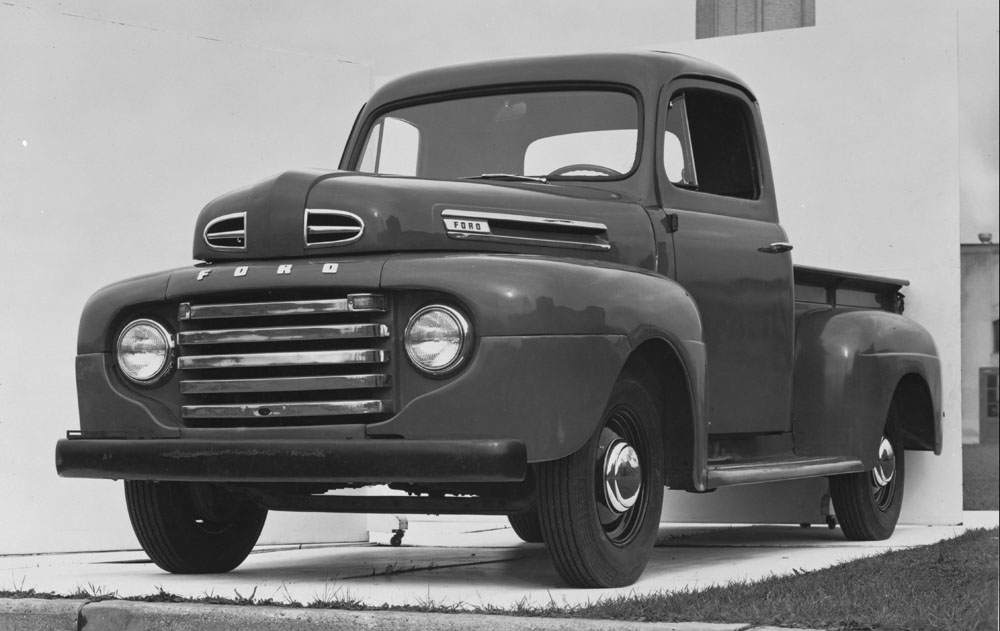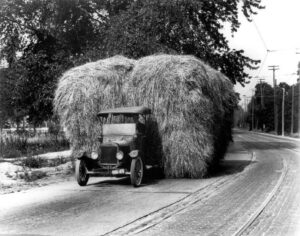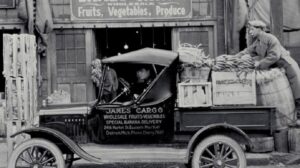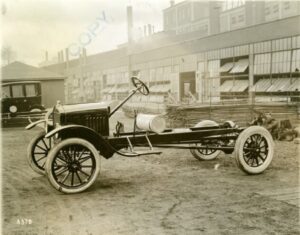Ford Truck History: Origins of the F-Series
Exploring the Beginnings of the Ford F-Series, the Most Popular Pickup of All Time.
Since 1981, the Ford F-Series enjoys the title of the best-selling vehicle in the United States. Today, the truck is available in a wide range of configurations for just about any application. From eco-friendly commuters to heavy-duty long-haul cargo trucks, the F-Series continues to evolve and adapt to a postmodern society. But at its fundamental core, it remains a pure, humble work truck. Such a philosophy is as timeless as it is universal. And while the latest generation is bestowed with all the amenities expected of modern vehicles, this principle remained a part of the F-Series’ genetics since its inception. That said, let’s take a trip back through time and explore why this principle came about, and how the American working men and women shaped it into what would become the original F-Series.
Origins of the Truck
Throughout the Industrial Revolution, the term “truck” was synonymous with the transit of cargo. Even the word truck is rooted in utility, stemming from the Greek word “Trokhos,” meaning wheel. All modern pickup trucks share a common ancestor: the Daimler Motor-Lastwagen. Built in 1896, the Motor-Lastwagen represents the first true internal-combustion pickup truck. With a 1.03L two-cylinder producing an Earth-shattering four-horsepower, the vehicle’s utility was immediately apparent with a 1500kg max payload on flat ground. And by the turn of the 20th century, the United States was getting in on the action as well. At this point, vehicles were almost always built to order. Some US coachbuilders began specializing in commercial chassis design, including tractors, public transport, fire engines, and haulers. The usefulness of the horseless carriage was still overshadowed by the traditional workhorse at this stage, but in 1908, everything would change.
The first Daimler Motor-Lastwagen was sold in Britain with an uprated 1.53L engine under the driver’s seat, making a total of 6 horsepower.
Ford Reinvents the Wheel
The Model T is nothing short of revolutionary for the transportation industry. Mass production and a 1916 $325 price tag meant that mechanized vehicles are now accessible by the average worker. Model T’s were built, both improvised and professionally, as everything from farm trucks to long-distance convoy vehicles. It was just as useful to bring electrification and mechanized agriculture to the frontier as it was a cargo transporter. Some companies, most famously American LaFrance, produced a firefighting variant that incorporated on-board equipment. Others had their axles adapted for use as railway vehicles. There was even a mobile church with a functioning organ. Dozens of companies supplied adapting kits for whatever application one could imagine. This reputation for ruggedness and practicality followed Ford throughout the 1920s, directly influencing the Model T’s successor.
The company most widely considered as the progenitor of the modern pickup was the Galion Godwin Truck Body Company. They produced the first official pickup bodies in 1913.
The Model AA was the next step in the Ford truck’s evolution, introducing Ford’s first closed-cab, factory pickup. It was also the first Ford with a conventional pedal layout, and the first vehicle with a safety glass windshield. Bodies were available in a variety of styles, including flatbeds, pickup beds, and panel vans. Its durability and price meant that it quickly overshadowed earlier GM-produced pickups from the mid-1920s. Within a year of its introduction, two million units were sold, and by 1930, the Model A was the de-facto quintessential American mover.
Ford produced a number of Model AA’s in specialized configurations, including: ambulance, dump truck, cab-only, hearse, among others. The US Postal Service employed AA’s with aftermarket panel bodies.
Trucking Through the Depression
By this point, the pickup truck was a firmly-established factory offering by Ford. One critical innovation was introduced with the 1932 Model B: the venerable flathead V8. This engine was produced in one form or another until the early 1980s. Its usefulness was immediately apparent, and the torquey V8 rapidly became required equipment for dedicated work trucks. In the light truck market, the V8 was also advantageous because the powerful, under-stressed engines required less maintenance than the overworked, aging 4-cylinders. From 1932 onward to the F-Series, every pickup on offer from Ford featured a V8, either optional or, more commonly, as standard.
Over the course of the 1930s, Ford trucks iterated on this basic template. A companion truck followed virtually every new model off the line. Ford also produced a greater variety of trucks in various trim levels in addition to their car line. As the recession set in, Ford decided to separate into two lines of consumer and upscale vehicles with the creation of Mercury on November 4, 1938. Between 1935 and 1940, over 3 million Fords left assembly lines across 5 US states. The truck model, distinguished as the Model 50 beginning in ‘35, solidified the concept of a simple, honest work truck into the American economy.
As the successor to the Model AA, the 1932 truck was called, appropriately, the Model BB. Photo by Alf van Beem
Lessons in War
Production for civilian vehicles froze on February 10, 1942. Ford enthusiastically embraced Roosevelt’s mandate, producing everything from trucks to tanks to B-24 bombers on its lines. The specific history of Ford during World War II goes far beyond just the politics of war, and is far beyond the scope of this article. That said, the utility and simplicity of the work truck was well-known to the US military. Many lessons were conveyed through the logistics of the military, pioneering multiple core concepts. Among these are all-wheel-drive systems, heavy-duty frames, specialized pullers and cranes, and large-displacement diesel engines.
Vehicles such as the Ford GPW/Willys MB proved the value of traction and simplicity through design; others like the CCKW conveyed the importance of dedicated heavy-duty logistics trucks. These lessons, among others, were incorporated into the design of a new era of vehicles. Following the end of World War II, most automakers resumed production as-is. Innovation in civilian vehicle design was all but frozen for the duration of the war, understandably so. But by 1946, Ford saw this as a unique opportunity. They weren’t just going to produce the same old pickups from 1942. This time, they were going all-in. They were going to create an all-new model, for utility vehicles only, from the ground up.
The Ford GPW was so versatile that it was even used as a light tank-destroyer, equipped with a 37mm gun. Such configurability became a defining trait of the F-series that followed.
The First Ford F-Series is Born
By 1947, all civilian Ford trucks in service were at least 5 years, if not decades, old. Customers returning from the war provided valuable input to Ford executives, and an all-new design was penned. This new truck would be more comfortable, more practical, roomier, and able to perform more jobs than ever before. The truck, now codenamed the F-series, marked the first American commercial vehicle designed after World War II.
No expense was spared; in total, Ford spent approximately 1 million dollars through research, tooling, and design iterations, leading to the advertising campaign for the “Million-Dollar Cab.” The chassis had several innovations in the works as well, including an all-new four-wheel-drive system and heavy-duty suspension. But more importantly, the truck was intended to encompass a range of body types, ranging from light to heavy-duty in various forms of specialization. Gone were the days of modifying a flatbed. These trucks were capable of the heaviest jobs right out of the box.
A New Truck for a New Age
The Ford F-Series began production November 27, 1947, and would ultimately require assembly lines across nine states to keep up with demand. A total of eight main variants were produced through to 1952, sequentially numbered from F-1 to F-8. These designations indicated the gross vehicle weight rating (GVWR), ranging from the lightest F-1 at 4,700 pounds, to the F-8 at 22,000 pounds. The F-1 proved the most popular offering by far, with the F-1 through F-3 platforms also serving as the basis for the 4-door panel trucks. Every year saw minor incremental changes such as moving the shifter from the floor to the column for 1950, or a revised cab and tailgate for 1951. But the critical objective was achieved. When Ford built the F-series, they got it right the first time.
Since its introduction, the Ford F-series has been a perennial mainstay on the road and the job site. With the introduction of the fourteenth generation for the 2021 model year, the classic formula has no doubt evolved over the years. From the well-rounded ‘50s to the straight and simple ‘60s; from the bold ‘80s to the refined 2000s and beyond. The F-series continuously demonstrates the inherent value of a universal, simple formula: a practical pickup truck that, first and foremost, is built to work.
Additional photos by Wikimedia Commons













